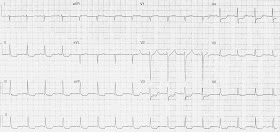He has a GCS of 3, BP 160 systolic and divergent pupils.
 |
| Click to enlarge |
Rate:
- 96 bpm
- Regular
- Sinus rhythm
- Right axis deviation
- PR - Normal
- QRS - Normal
- ST Depression leads II, III, aVL, V3-6
- ST Elevation aVR & aVL
Additional:
Remember the ECG is a test that must be taken to the bedside
In a young trauma patient with significant ST segment and T wave changes there are three main considerations:
In this patient there was no suspicion of a proceeding medical event precipitating the event and no evidence of blunt chest injury including clinical features, plain imaging and bedside USS assessment. The patient had sustained an isolated catastrophic head injury which was unfortunately unsurvivable.
Blunt Cardiac Injury
The American Association for the Surgery of Trauma has a very nice overview of blunt cardiac injury here:
ECG Changes Associated with Neurological Pathology
ECG changes are well described in the setting of neurological pathology, especially subarachnoid haemorrhage. but can occur in traumatic brain injury. There following is a nice overview of pathophysiology and outcome effects of cardiovascular abnormalities associated with brain injury:
References / Further Reading
Life in the Fast Lane
Textbook
- Biphasic T wave in leads V3-4
Remember the ECG is a test that must be taken to the bedside
In a young trauma patient with significant ST segment and T wave changes there are three main considerations:
- Traumatic Brain Injury causing ECG changes
- Blunt chest injury causing ECG changes
- Cardiac event precipitating accident
- ? Drug ingestion / vasospasm
- ? Coronary dissection
In this patient there was no suspicion of a proceeding medical event precipitating the event and no evidence of blunt chest injury including clinical features, plain imaging and bedside USS assessment. The patient had sustained an isolated catastrophic head injury which was unfortunately unsurvivable.
Blunt Cardiac Injury
The American Association for the Surgery of Trauma has a very nice overview of blunt cardiac injury here:
ECG Changes Associated with Neurological Pathology
ECG changes are well described in the setting of neurological pathology, especially subarachnoid haemorrhage. but can occur in traumatic brain injury. There following is a nice overview of pathophysiology and outcome effects of cardiovascular abnormalities associated with brain injury:
References / Further Reading
Life in the Fast Lane
Textbook
- Chan TC, Brady WJ, Harrigan RA, Ornato JP, Rosen P. ECG in Emergency Medicine and Acute Care. Elsevier Mosby 2005.
No comments:
Post a Comment